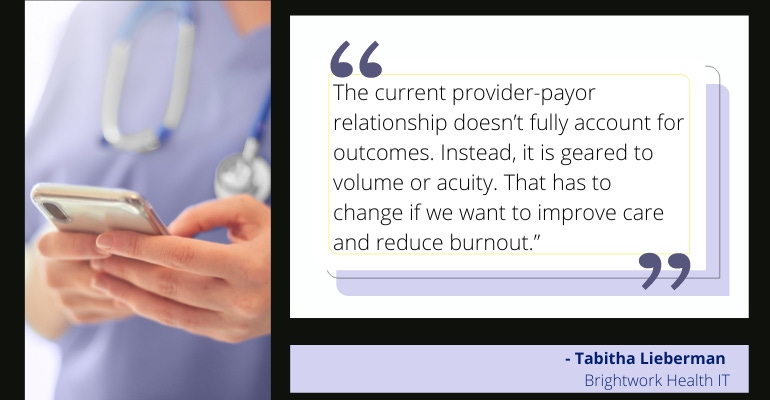Should Health Systems Monetize Physician Messages to Patients?
Leading healthcare systems across the country are now billing patients when their doctors send them messages through tools like Epic's MyChart.
January 4, 2023

Leading healthcare systems across the country are now billing patients when their doctors send them messages.
For some, the out-of-pocket cost could go up to $50, or more, to ask questions about new symptoms or a change in medication.
This is in response to the increasing burden created by patient engagement platforms.
“It’s a delicate balance,” said Tabitha Lieberman, president of EHR and healthcare applications at Brightwork Health IT. “On the one hand, health systems need these tools to help streamline operations and reduce costs. On the other, they find themselves spending more hours at the end of the day responding to patients.”
Brightwork Health IT helps healthcare organizations with large technology implementations, digital transformation initiatives, and technical resources. And Lieberman, who recently joined the firm, knows a thing or two about the inner workings of healthcare. She has worked at several large health systems, most recently spending a decade as part of the leadership team at Providence St. Joseph Health.
Lieberman also noted that the billing controversy pits the needs of providers versus patients as health systems also weigh how to manage a necessary tool that’s become an increasing drain on resources.
The Cleveland Clinic, University of California San Francisco, and Northwestern Medicine are among a few of the health systems that started billing patients for certain MyChart messages. The messages are those that generally take more time and expertise to handle like patients reporting new symptoms, medication adjustments, or changes in a chronic condition.
The Cleveland Clinic reported out-of-pocket costs could go up to $50 for some customers.
Tools like Epic’s MyChart let patients schedule appointments or request prescription refills. They free up staff from answering phones or managing routine matters to take on more complex tasks. They also give patients greater control and autonomy to manage their own care.
For providers, it allows for better communication with patients and streamlines administrative operations. Patient registration can take place in a portal versus in person or over the phone. Insurance information is easily added and accessible.
Lieberman noted how online portals have transformed and helped healthcare.
“Systems like Epic’s MyChart have been a game changer, drawing patients and doctors closer together while leading to better health outcomes,” she said.
These tools have only increased in popularity, especially during the COVID-19 pandemic. Since 2020, patients have sent 157% more messages on platforms like Epic’s MyChart, according to a study in the Journal of the American Medical Informatics Association (JAMIA).
But as the volume has grown, so has the time and resources needed to manage it.
“Message management has been a challenge for years,” Lieberman said. “But the current staffing challenges have made it even more difficult to manage the volume.”
Healthcare systems around the country are grappling with staffing shortages at all levels.
For example, the shortage for nurses is expected to grow to 1.1 million by the end of 2022, according to the U.S. Bureau of Labor Statistics.
A study by consulting firm Mercer projected this trend will continue for years, with demand outstripping supply by tens of thousands healthcare workers.
This means providers at healthcare systems are doing more work but with fewer resources to manage them.
Compounding the problem is the amount of time providers spend responding to patients on platforms like MyChart. Online patient portals have been taking more and more of doctors’ time.
A 2017 study in the Annals of Family Medicine found primary care physicians averaged two hours a day on electronic health record tasks and spent another four on administrative tasks.
The increased burden has only exasperated stress and burnout on providers.
It’s particularly taxing for the doctors who respond the most to patients.
Doctors who extensively replied to patients (the top 25% in message volume) were six times more likely to have “high exhaustion,” according to the JAMIA study.
Provider burnout is very real and MyChart messages have increased due to both the pandemic and regulatory changes,” Lieberman said.
And worse for physicians and health systems, the two hours they spend on messages daily is unbilled.
The American healthcare system is largely fee-for-service. It pays providers by the quantity of tests and procedures they perform.
But it doesn’t account for messages a patient and doctor may swap on platforms like MyChart. No actual service is performed. Because no service is performed, there is nothing to bill.
Some healthcare systems like Cleveland Clinic are trying to change that. They have opted to start charging for messages that take more time and analysis from their physicians. Does the doctor have to make a clinical decision? If so, they’ll bill a patient's insurance carrier. The company may then pass it onto subscribers as an out-of-pocket cost.
Lieberman offered a different approach to the dilemma: embrace a value-based care model.
“We need to change our entire U.S.-based healthcare system to be outcome driven vs widget driven, and fairly compensate primary care for their role in overall health,” she said.
Value-based care ties payment to patient health. When a patient does better, the provider and health systems are rewarded. This model also promotes efficient care. So there’s no emphasis on the quantity of services or procedures. Just how care is delivered and the end result.
"The current provider-payor relationship doesn’t fully account for outcomes,” Lieberman said. “Instead, it is geared to volume or acuity. That has to change if we want to improve care and reduce burnout.”
About the Author(s)
You May Also Like


